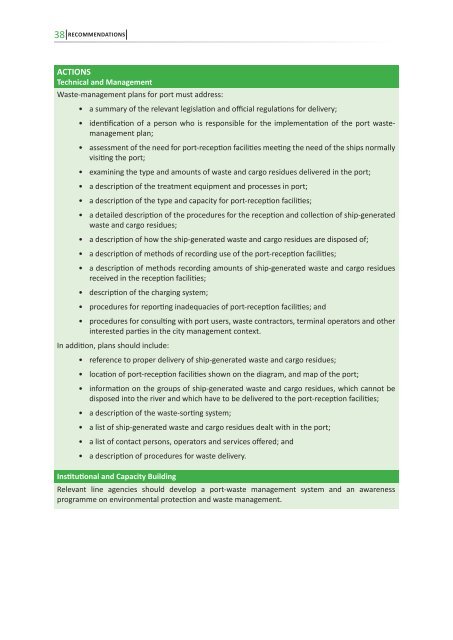Carriage, Handling and Storage of Dangerous Goods along
Carriage, Handling and Storage of Dangerous Goods along
Carriage, Handling and Storage of Dangerous Goods along
Create successful ePaper yourself
Turn your PDF publications into a flip-book with our unique Google optimized e-Paper software.
38 RECOMMENDATIONS<br />
ACTIONS<br />
Technical <strong>and</strong> Management<br />
Waste-management plans for port must address:<br />
• a summary <strong>of</strong> the relevant legislation <strong>and</strong> <strong>of</strong>ficial regulations for delivery;<br />
• identification <strong>of</strong> a person who is responsible for the implementation <strong>of</strong> the port wastemanagement<br />
plan;<br />
• assessment <strong>of</strong> the need for port-reception facilities meeting the need <strong>of</strong> the ships normally<br />
visiting the port;<br />
• examining the type <strong>and</strong> amounts <strong>of</strong> waste <strong>and</strong> cargo residues delivered in the port;<br />
• a description <strong>of</strong> the treatment equipment <strong>and</strong> processes in port;<br />
• a description <strong>of</strong> the type <strong>and</strong> capacity for port-reception facilities;<br />
• a detailed description <strong>of</strong> the procedures for the reception <strong>and</strong> collection <strong>of</strong> ship-generated<br />
waste <strong>and</strong> cargo residues;<br />
• a description <strong>of</strong> how the ship-generated waste <strong>and</strong> cargo residues are disposed <strong>of</strong>;<br />
• a description <strong>of</strong> methods <strong>of</strong> recording use <strong>of</strong> the port-reception facilities;<br />
• a description <strong>of</strong> methods recording amounts <strong>of</strong> ship-generated waste <strong>and</strong> cargo residues<br />
received in the reception facilities;<br />
• description <strong>of</strong> the charging system;<br />
• procedures for reporting inadequacies <strong>of</strong> port-reception facilities; <strong>and</strong><br />
• procedures for consulting with port users, waste contractors, terminal operators <strong>and</strong> other<br />
interested parties in the city management context.<br />
In addition, plans should include:<br />
• reference to proper delivery <strong>of</strong> ship-generated waste <strong>and</strong> cargo residues;<br />
• location <strong>of</strong> port-reception facilities shown on the diagram, <strong>and</strong> map <strong>of</strong> the port;<br />
• information on the groups <strong>of</strong> ship-generated waste <strong>and</strong> cargo residues, which cannot be<br />
disposed into the river <strong>and</strong> which have to be delivered to the port-reception facilities;<br />
• a description <strong>of</strong> the waste-sorting system;<br />
• a list <strong>of</strong> ship-generated waste <strong>and</strong> cargo residues dealt with in the port;<br />
• a list <strong>of</strong> contact persons, operators <strong>and</strong> services <strong>of</strong>fered; <strong>and</strong><br />
• a description <strong>of</strong> procedures for waste delivery.<br />
Institutional <strong>and</strong> Capacity Building<br />
Relevant line agencies should develop a port-waste management system <strong>and</strong> an awareness<br />
programme on environmental protection <strong>and</strong> waste management.













